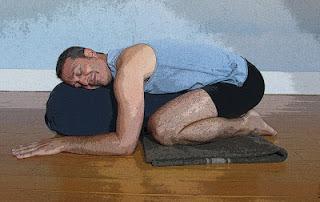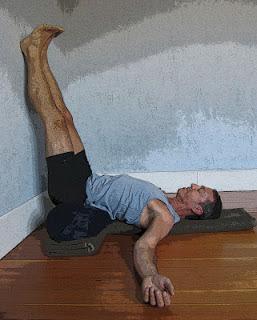
Supported Child's Pose
A dear friend of mine, with whom I’ve stayed with on many vacations and have been traveling with, suffers from terrible migraines, the kind where all you can do is curl up on the fetal position for 24 hours in a dark room. So even though I don’t have migraines myself, I’ve witnessed first hand how awful they can be. Baxter had some good suggestions yesterday (see Yoga for Migraine Headaches) for how to use yoga to get through a migraine headache. But wouldn’t it be nice if you didn’t have to get a migraine in the first place?Unfortunately, since there are many different triggers for migraines, including different types of food, it is impossible for us to give you any guaranteed solutions. However, we do have some recommendations for yoga practices you can try out. Suffering from a migraine is such a miserable experience and these yoga practices will benefit you in many other ways, so it really seems worth giving them a shot. And everything we’re going to suggest here applies to ordinary tension headaches as well as to migraines, so listen up, everyone!
In his book Yoga As Medicine, Timothy McCall identifies two possible triggers for migraines and other headaches that we can address with yoga: stress and muscle tension in the head, neck and back areas. Today I’m going to talk stress and tomorrow I’ll post something about muscle tension.
Okay, now to address stress. In his book, Timothy says, “Since stress is a major factor in both tension headaches and in migraines, yoga can certainly play a role in prevention.” And he goes on to say that “There is scientific evidence that relaxation techniques and biofeedback can be effective for both tension and migraine headaches, lessening the duration as well as the frequency of attacks.” That sounds pretty promising to me!
I’ve been ranting about the subject of chronic stress and the importance of stress management since we started the blog (see Chronic Stress: An Introduction and The Relaxation Response and Yoga), but as a reminder, I’ll simply reiterate that yoga provides a huge selection of possibilities for stress management and you can pick and choose from amongst them according to your experience level, temperament, schedule, and/or personal preference. All of the following yoga techniques reduce your stress levels by switching your nervous system from stress mode (Flight or Fight) to relaxation mode (Rest and Digest), something you cannot achieve with a nap or even a full-night’s sleep (see Conscious Relaxation vs. Sleep).
• Meditation. See How to Meditate for information on how to meditate.
• Breath practices (pranayama). See Your Key to Your Nervous System for information your nervous system and your breath. For stress reduction and headache prevention, be sure to avoid stimulating and/or overly complex breath practices and focus on simple, calming practices.
• Restorative poses with a focus for the mind (such as your breath or the relaxation of your muscles).
• Inverted poses. Studies by Dr. Roger Cole proved that inverted and semi-inverted poses, where your heart is higher than your head, trigger the relaxation response through the mechanisms that control your blood pressure. This is why supported inversions, such Legs Up the Wall pose and Easy Inverted Pose (legs on a chair), are so effective for stress management (See Just in Time for the Holidays: Inverted Poses).
• Corpse pose (Savasana) with a focus for your mind (such as your breath, the relaxation of your muscles, or peaceful imagery). See Savasana for information.
• Yoga nidra (yogic sleep), a long, structured form of Savasana. See What is Yoga Nidra? for information about yoga nidra and the Audio Tracks tab at the top of the page for a mini version of yoga nidra that you can stream or download.
If you find it difficult to settle in and relax because you’re too restless or anxious when you lie down, first try any active asana practice to burn off steam (although you might want to be careful with backbends—I’ll address that tomorrow) and then move on to relaxation practices.
If you are interested in practicing a combination of inverted and restorative poses, you might like to check the headache sequence in Yoga As Medicine, which includes the following poses:
- Legs Up the Wall pose
- Supported Reclined Cobbler’s pose
- Chair Shoulderstand
- Half Plow Pose (with chair)
- One-Legged Forward Bend with head support
- Full Seated Forward Bend with head support
- Breath Awareness

So how often should you do these stress reduction practices? I think that if you are chronically stressed out and suffering from debilitating headaches, you should practice six or seven days a week for at least 15 minutes (keep in mind that could be 15 minutes of meditation or 15 minutes in Legs Up the Wall pose). I realize that sounds like a lot, but it will take some work—if you can call relaxing “work”—to bring your overall stress levels down. The payoffs could be huge, however, as stress management can result in many additional health benefits besides reduced headaches, such as lower blood pressure and a stronger immune system, as well as quality of life benefits, such as increased equanimity and maybe even happiness. And if any of you take up this headache reduction challenge, I’d love to hear back from you about the results.
Check back tomorrow for tips about how to use yoga poses to release neck, shoulder and back tension that can trigger headaches.

